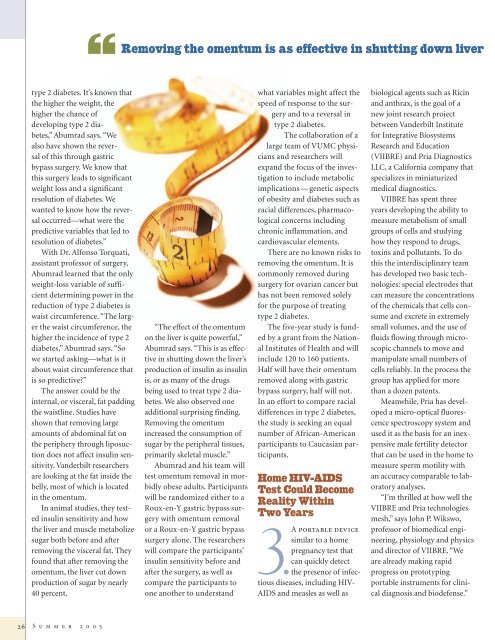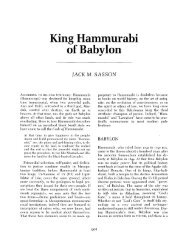From the Editor From the Reader - DiscoverArchive Home ...
From the Editor From the Reader - DiscoverArchive Home ...
From the Editor From the Reader - DiscoverArchive Home ...
Create successful ePaper yourself
Turn your PDF publications into a flip-book with our unique Google optimized e-Paper software.
26<br />
type 2 diabetes. It’s known that<br />
<strong>the</strong> higher <strong>the</strong> weight, <strong>the</strong><br />
higher <strong>the</strong> chance of<br />
developing type 2 diabetes,”<br />
Abumrad says. “We<br />
also have shown <strong>the</strong> reversal<br />
of this through gastric<br />
bypass surgery. We know that<br />
this surgery leads to significant<br />
weight loss and a significant<br />
resolution of diabetes. We<br />
wanted to know how <strong>the</strong> reversal<br />
occurred—what were <strong>the</strong><br />
predictive variables that led to<br />
resolution of diabetes.”<br />
With Dr. Alfonso Torquati,<br />
assistant professor of surgery,<br />
Abumrad learned that <strong>the</strong> only<br />
weight-loss variable of sufficient<br />
determining power in <strong>the</strong><br />
reduction of type 2 diabetes is<br />
waist circumference. “The larger<br />
<strong>the</strong> waist circumference, <strong>the</strong><br />
higher <strong>the</strong> incidence of type 2<br />
diabetes,” Abumrad says. “So<br />
we started asking—what is it<br />
about waist circumference that<br />
is so predictive?”<br />
The answer could be <strong>the</strong><br />
internal, or visceral, fat padding<br />
<strong>the</strong> waistline. Studies have<br />
shown that removing large<br />
amounts of abdominal fat on<br />
<strong>the</strong> periphery through liposuction<br />
does not affect insulin sensitivity.<br />
Vanderbilt researchers<br />
are looking at <strong>the</strong> fat inside <strong>the</strong><br />
belly, most of which is located<br />
in <strong>the</strong> omentum.<br />
In animal studies, <strong>the</strong>y tested<br />
insulin sensitivity and how<br />
<strong>the</strong> liver and muscle metabolize<br />
sugar both before and after<br />
removing <strong>the</strong> visceral fat. They<br />
found that after removing <strong>the</strong><br />
omentum, <strong>the</strong> liver cut down<br />
production of sugar by nearly<br />
40 percent.<br />
S u m m e r 2 0 0 5<br />
“Removing <strong>the</strong> omentum is as effective in shutting down liver<br />
“The effect of <strong>the</strong> omentum<br />
on <strong>the</strong> liver is quite powerful,”<br />
Abumrad says. “This is as effective<br />
in shutting down <strong>the</strong> liver’s<br />
production of insulin as insulin<br />
is, or as many of <strong>the</strong> drugs<br />
being used to treat type 2 diabetes.<br />
We also observed one<br />
additional surprising finding.<br />
Removing <strong>the</strong> omentum<br />
increased <strong>the</strong> consumption of<br />
sugar by <strong>the</strong> peripheral tissues,<br />
primarily skeletal muscle.”<br />
Abumrad and his team will<br />
test omentum removal in morbidly<br />
obese adults. Participants<br />
will be randomized ei<strong>the</strong>r to a<br />
Roux-en-Y gastric bypass surgery<br />
with omentum removal<br />
or a Roux-en-Y gastric bypass<br />
surgery alone. The researchers<br />
will compare <strong>the</strong> participants’<br />
insulin sensitivity before and<br />
after <strong>the</strong> surgery, as well as<br />
compare <strong>the</strong> participants to<br />
one ano<strong>the</strong>r to understand<br />
what variables might affect <strong>the</strong><br />
speed of response to <strong>the</strong> surgery<br />
and to a reversal in<br />
type 2 diabetes.<br />
The collaboration of a<br />
large team of VUMC physicians<br />
and researchers will<br />
expand <strong>the</strong> focus of <strong>the</strong> investigation<br />
to include metabolic<br />
implications—genetic aspects<br />
of obesity and diabetes such as<br />
racial differences, pharmacological<br />
concerns including<br />
chronic inflammation, and<br />
cardiovascular elements.<br />
There are no known risks to<br />
removing <strong>the</strong> omentum. It is<br />
commonly removed during<br />
surgery for ovarian cancer but<br />
has not been removed solely<br />
for <strong>the</strong> purpose of treating<br />
type 2 diabetes.<br />
The five-year study is funded<br />
by a grant from <strong>the</strong> National<br />
Institutes of Health and will<br />
include 120 to 160 patients.<br />
Half will have <strong>the</strong>ir omentum<br />
removed along with gastric<br />
bypass surgery, half will not.<br />
In an effort to compare racial<br />
differences in type 2 diabetes,<br />
<strong>the</strong> study is seeking an equal<br />
number of African-American<br />
participants to Caucasian participants.<br />
<strong>Home</strong> HIV-AIDS<br />
Test Could Become<br />
Reality Within<br />
Two Years<br />
device<br />
similar to a home<br />
pregnancy test that<br />
can quickly detect<br />
<strong>the</strong> presence of infectious<br />
diseases, including HIV-<br />
AIDS and measles as well as<br />
3.A portable<br />
biological agents such as Ricin<br />
and anthrax, is <strong>the</strong> goal of a<br />
new joint research project<br />
between Vanderbilt Institute<br />
for Integrative Biosystems<br />
Research and Education<br />
(VIIBRE) and Pria Diagnostics<br />
LLC, a California company that<br />
specializes in miniaturized<br />
medical diagnostics.<br />
VIIBRE has spent three<br />
years developing <strong>the</strong> ability to<br />
measure metabolism of small<br />
groups of cells and studying<br />
how <strong>the</strong>y respond to drugs,<br />
toxins and pollutants. To do<br />
this <strong>the</strong> interdisciplinary team<br />
has developed two basic technologies:<br />
special electrodes that<br />
can measure <strong>the</strong> concentrations<br />
of <strong>the</strong> chemicals that cells consume<br />
and excrete in extremely<br />
small volumes, and <strong>the</strong> use of<br />
fluids flowing through microscopic<br />
channels to move and<br />
manipulate small numbers of<br />
cells reliably. In <strong>the</strong> process <strong>the</strong><br />
group has applied for more<br />
than a dozen patents.<br />
Meanwhile, Pria has developed<br />
a micro-optical fluorescence<br />
spectroscopy system and<br />
used it as <strong>the</strong> basis for an inexpensive<br />
male fertility detector<br />
that can be used in <strong>the</strong> home to<br />
measure sperm motility with<br />
an accuracy comparable to laboratory<br />
analyses.<br />
“I’m thrilled at how well <strong>the</strong><br />
VIIBRE and Pria technologies<br />
mesh,” says John P. Wikswo,<br />
professor of biomedical engineering,<br />
physiology and physics<br />
and director of VIIBRE. “We<br />
are already making rapid<br />
progress on prototyping<br />
portable instruments for clinical<br />
diagnosis and biodefense.”
















